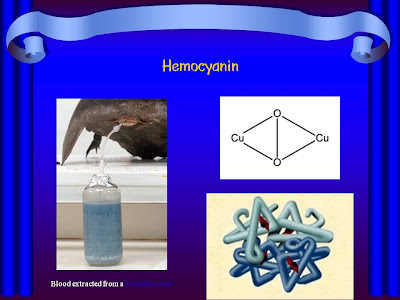I was wondering about this very concept a few weeks ago. What would make blood turn a different color? Like in Vulcans, it is green. Andalites have blue blood but... how does it scientifically work? I mean, our blood turns red once it escapes through our skin or vein because while inside, it is deep purple because of the oxygen.
The simple answer is that oxidized iron shows red (rust ranges from orange to red) and oxidized copper shows blue (or between blue and green, as seen on old pennies and the Statue of Liberty.)
It took me a while to find an actual picture of what blue blood looks like, but here's an example of only partly-oxygenated blood from a horseshoe crab. Put in spoilers because, well, it IS blood, which makes some people faint. Plus you gotta feel kinda bad for the crab.
[spoiler]

[/spoiler]
Copy-pasted from the blog I found this picture at (Thanks to this blog BTW), here are some facts about hemocyanin, the copper equivalent of hemoglobin:
Hemocyanin:
Similar to hemoglobin founded in vertebrates.
Found in arthropods (especially crustaceans) and many molluscs.
In the form of metalloproteins containing two copper atoms that reversibly bind a single oxygen molecule (O2). (Makes the blood blue from Cu2+ ion)
Colourless when deoxygenated. (The blood appears as grey-white to pale yellow, due to the tissue fluid.)
Dark blue when oxygenated.
Most hemocyanins bind with oxygen non-cooperatively and are roughly one-fourth as efficient as hemoglobin at transporting oxygen per amount of blood.
In some hemocyanins of horseshoe crabs and some other species of arthropods, cooperative binding is observed, with Hill coefficients between 1.6-3. (Hemoglobin for comparison has a Hill coefficient of usually 2.8-3)
In case of cooperative binding, hemocyanin was arranged in protein sub-complexes of 6 subunits (hexamer), each with one oxygen binding site.
Binding of oxygen on one unit in the complex would increase the affinity of the neighboring units.
Hemocyanin oxygen-binding profile is also affected by dissolve-salt ion levels and pH.
Hemocyanin oxygen transportation is more efficient than hemoglobin oxygen transportation in case of an animal that live in the cold environments and low oxygen pressure condition. (where several important marine invertebrates such as shrimps, crabs lives)
So all in all, from the looks of it, doesn't look super likely for Andalites, as we know they don't live in very cold areas from #25. However, they might have some structure that is similar to, but not exactly, hemocyanin. After all, it IS alien biology. They may have differently shaped blood cells that make up in surface area for hemocyanin's small oxygen capacity; they may only require a little oxygen, and be more reliant on, say, CO2 or hydrogen. They may have more hexamers than six in their pseudo-hemocyanin... basically I'm just saying is, theoretically, it could still work. XD